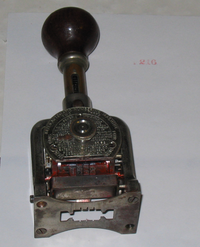- Bates numbering
-
Bates numbering (also known as Bates stamping, Bates branding, Bates coding or Bates labeling) is used in the legal, medical, and business fields to place identifying numbers and/or date/time-marks on images and documents as they are scanned or processed (for example, during the discovery stage of preparations for trial or identifying business receipts). Bates stamping can be used to mark and identify images with copyrights by putting a company name, logo and/or legal copyright on them. This process provides identification, protection, and auto-increment numbering of the images.
History
The first Bates Stamping machine was invented in 1892 by the Bates Manufacturing Company in NJ. It was advertised as the first automatic Bates numbering machine ever to be created. Each time the machine was pressed down onto a sheet of paper, a rotating wheel incremented by one. Pages were numbered using a six-digit sequence. For example, page 852 in a document set would be 000852. Courts and law firms quickly adopted this system which is commonly referred to as Bates Numbering.[1]
Usage
Bates numbering is commonly used as an organizational method to label and identify legal documents. Nearly all American law firms use Bates stamps, though the use of manual hand-stamping is becoming increasingly rare due to the rise in electronic bates numbering (mostly in PDF format), rather than printed, material. During the discovery phase of litigation, a large number of documents might necessitate the use of unique identifiers for each page of each document for reference and retrieval. Bates numbering (named for the Bates automatic numbering machine) assigns an arbitrary unique identifier to each page. Such "numbering" may be solely numeric or may contain a combination of letters and numbers (alphanumeric). There is no standard method for numbering documents.
Manual Bates stamping uses a self inking stamp with numbered wheels (4, 5, 6, and 7-wheeled models are known) which automatically increments each time the stamp is pressed down on a page. (Some stamps allow for duplicate documents by only incrementing after two or more presses).
Pre-printed self-adhesive labels are common today as is electronic document discovery (EDD) software that can electronically "stamp" documents stored as computer files by superimposing numbers onto them. The Bates Automatic Numbering Machine has been steadily replaced by such software, except in cases where electronic versions of the documents are not available or are not practical to produce.
The Bates Automatic Numbering Machine was patented in 1891-93 by the Bates Manufacturing Company of Edison, NJ.
There seems to be no documented standard for Font and Font Size attributed to Bates numbering.
References
- ^ "Bates Numbering Legal Documents". Infordesk's ParmisPDF. March 11, 2010. http://www.parmispdf.com/pdf_bates_numbering.php.}}

This tool article is a stub. You can help Wikipedia by expanding it.

